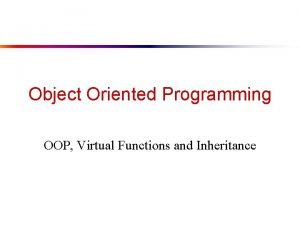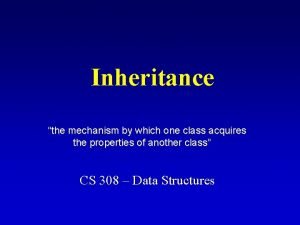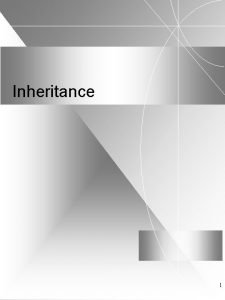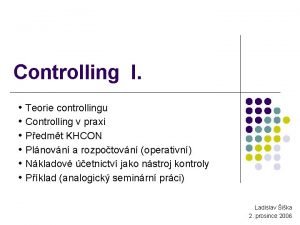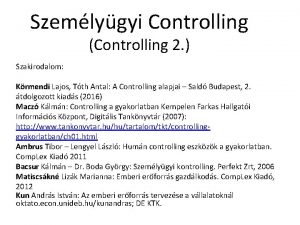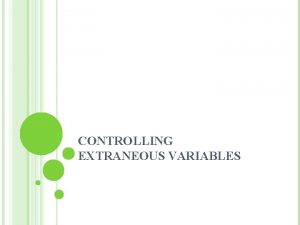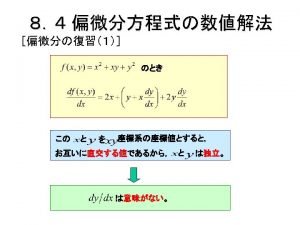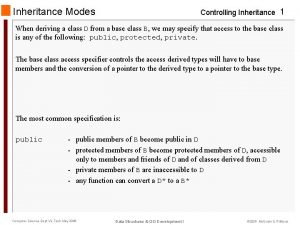Controlling Inheritance II 1 Controlling Inheritance Private Inheritance














- Slides: 14

Controlling Inheritance II 1 Controlling Inheritance Private Inheritance Example Non-Public Inheritance Usage Specialization: Replacing Inherited Methods Solution: Redefine Base Method Extending Inherited Methods Modify Hourly. Employee to Extend Print() Hiding Inherited Methods Dealing with an Embarrassing Base Method Overriding an Embarrassing Base Method Use Private Inheritance Revise Inheritance Hierarchy Computer Science Dept Va Tech January 2000 OO Software Design and Construction © 2000 Mc. Quain WD

Inheritance Modes Inheritance II 2 When deriving a class, we may specify the inheritance to be any of: public all members of the base class are inherited with the same access protections as they had in the base class protected become public and protected members of the base class protected members of the derived class* private public and protected members of the base class become private members of the derived class* * I. e. , users of the derived class have NO access to the public interface of the base class. Computer Science Dept Va Tech January 2000 OO Software Design and Construction © 2000 Mc. Quain WD

Private Inheritance Example Inheritance II 3 class Hourly. Employee : private Employee { private: double Rate; double Hours; public: Hourly. Employee(); Hourly. Employee(string FN, string LN, string ID, double R, double H); double get. Rate() const; double get. Hours() const; void set. Rate(double R); void set. Hours(double H); ~Hourly. Employee(); }; Hourly. Employee Fred(“Fred”, “Frid”, “ 10078”, 9. 78, 40); string Ident = Fred. get. ID(); // illegal Now a user of the Hourly. Employee class cannot directly call the inherited Employee member function get. ID(). Computer Science Dept Va Tech January 2000 OO Software Design and Construction © 2000 Mc. Quain WD

Private Inheritance Example Inheritance II 4 class Hourly. Employee : private Employee { private: double Rate; double Hours; public: Hourly. Employee(); Hourly. Employee(string FN, string LN, string ID, double R, double H); double get. Rate() const; double get. Hours() const; void set. Rate(double R); void set. Hours(double H); string get. ID() const; string get. Name() const; ~Hourly. Employee(); }; string Hourly. Employee: : get. ID() const { return ID; } Providing a public Hourly. Employee member function restores access. Computer Science Dept Va Tech January 2000 OO Software Design and Construction © 2000 Mc. Quain WD

Non-Public Inheritance Usage Inheritance II 5 Private inheritance is appropriate when the public interface of the base class is not needed by the user of the derived class, or if it is desirable to hide the public interface of the base class from the user. Of course, this will also render any protected members of the base class inaccessible in the derived class. For that reason private inheritance is used much less often than public inheritance. Similarly, protected inheritance is appropriate when the public interface of the base class must be hidden from the user of the derived class, but the protected and public interface of the base class is useful in the implementation of the derived class. Computer Science Dept Va Tech January 2000 OO Software Design and Construction © 2000 Mc. Quain WD

Specialization: Replacing Inherited Methods Inheritance II 6 Problem: You have a base class. You’re writing a derived class to provide a specialization. You don’t like the implementation of a member function in the base class! You want to redefine the member function. class Employee { private: string FName; string LName; string ID; public: . . . void. . . }; void Employee: : set. ID(string Ident) { ID = Ident; } set. ID(string Ident); However: the ID of an hourly employee must begin with a character signifying the employee’s pay rate category (say: A, B, C, . . . ). Computer Science Dept Va Tech January 2000 OO Software Design and Construction © 2000 Mc. Quain WD

Solution: Redefine Base Method Inheritance II 7 In the derived class, provide an appropriate implementation, using the same interface. That will override the base class version when invoked on an object of the derived type: void Hourly. Employee: : set. ID(string Ident) { string IDprefix = get. Prefix(Rate); } ID = IDprefix + Ident; The appropriate member function implementation is chosen (at compile time), based upon the type of the invoking object and the inheritance hierarchy. Beginning with the derived class, the hierarchy is searched upward until a matching function definition is found: Hourly. Employee Fred(“Fred”, “Frid”, “ 10078”, 9. 78, 40); Fred. set. ID(“ 214801”); Computer Science Dept Va Tech January 2000 OO Software Design and Construction © 2000 Mc. Quain WD

Extending Inherited Methods Inheritance II 8 Problem: You have a base class. You’re writing a derived class. A member function in the base class is “not quite” OK. You want to extend the base member function. class Employee { private: string FName; string LName; string ID; void Employee: : Print(ostream& Out) { Out << LName << “, ” << FName << ‘t’ << ID << endl; } public: . . . void Print(ostream& Out); . . . }; However: we’re adding a Department field for hourly and salaried employees, and we want to print that on the next line… Computer Science Dept Va Tech January 2000 OO Software Design and Construction © 2000 Mc. Quain WD

Modify Hourly. Employee to Extend Print() Inheritance II 9 In the derived class, provide an appropriate implementation, using the same interface. However, now we still want to use the base member function (to avoid code duplication), just add functionality: void Hourly. Employee: : Print(ostream& Out) { Employee: : Print(Out); } Out << Department << endl; Within an inheritance hierarchy, we can invoke a member function of a base type by specifying the name of that type via the scope resolution operator. Computer Science Dept Va Tech January 2000 OO Software Design and Construction © 2000 Mc. Quain WD

Hiding Inherited Methods Inheritance II 10 Sometimes a member function from the base type simply doesn’t make sense within the context of a derived type. What do we do? class Rectangle { protected: Location NW; double Length, Width; public: . . . void Re. Scale(double Factor); void Re. Size(double L, double W) {Length = L; Width = W; }. . . }; We don’t want to allow a Square to not have Length == Width How to prevent that…? class Square : public Rectangle { public: . . . }; Computer Science Dept Va Tech January 2000 OO Software Design and Construction © 2000 Mc. Quain WD

Dealing with an Embarrassing Base Method Inheritance II 11 There are three strategies: 1. Override the base member function so it’s harmless. 2. Use private inheritance so the base method isn’t visible to the user of the derived class. 3. Revise the inheritance hierarchy to make it more appropriate. Let’s look at all three. . . Computer Science Dept Va Tech January 2000 OO Software Design and Construction © 2000 Mc. Quain WD

Overriding an Embarrassing Base Method Inheritance II 12 void Square: : Re. Size(double L, double W) { } if (L == W) { Length = L; Width = W; } or void Square: : Re. Size(double L, double W) { } Rectangle: : Re. Size(L, L); What are the pros and cons for this solution? Computer Science Dept Va Tech January 2000 OO Software Design and Construction © 2000 Mc. Quain WD

Use Private Inheritance II 13 This will render Rectangle: : Re. Size() invisible to the user who declares an object of type Square. That eliminates any chance the user could incorrectly use the inappropriate base class member function. What are the pros and cons for this solution? class Square : Rectangle { // default mode is private public: . . . }; Computer Science Dept Va Tech January 2000 OO Software Design and Construction © 2000 Mc. Quain WD

Inheritance II 14 Revise Inheritance Hierarchy It doesn’t really make sense to say that a square is a rectangle (HS geometry books notwithstanding) … However, it DOES make sense to say that squares and rectangles are kinds of quadrilaterals: Quadrilateral ? ? Square Rectangle Scale Re. Size Computer Science Dept Va Tech January 2000 OO Software Design and Construction © 2000 Mc. Quain WD
 Private inheritance
Private inheritance Private inheritance
Private inheritance Private inheritance
Private inheritance Controlling vibration
Controlling vibration Perbedaan controlling dan evaluating
Perbedaan controlling dan evaluating Controlling v praxi
Controlling v praxi Controlling a gyakorlatban
Controlling a gyakorlatban Thesis statement controlling idea
Thesis statement controlling idea Coherent paragraph examples
Coherent paragraph examples What are extraneous variables
What are extraneous variables Controlling marketing operations
Controlling marketing operations Whats a controlling idea
Whats a controlling idea Process of controling
Process of controling Pengertian asas-asas manajemen menurut para ahli
Pengertian asas-asas manajemen menurut para ahli Who are manager
Who are manager
